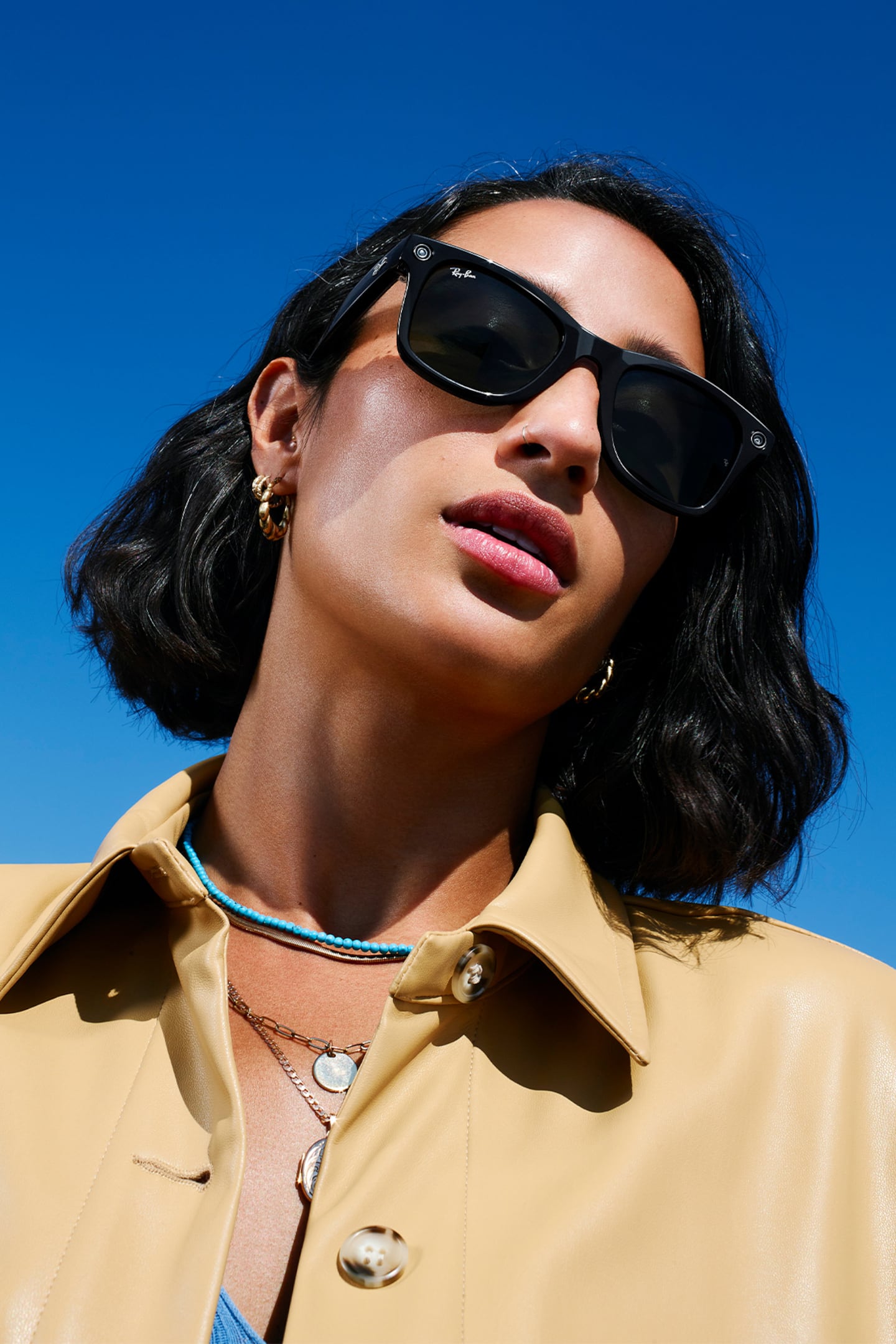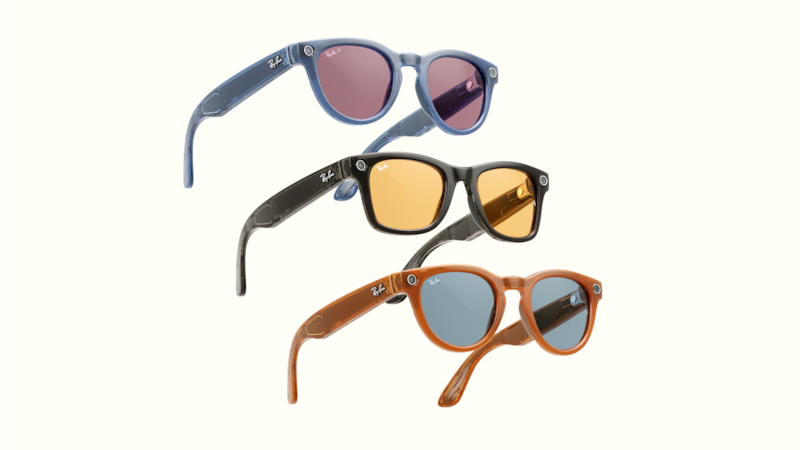
The Business of Fashion
Agenda-setting intelligence, analysis and advice for the global fashion community.

Agenda-setting intelligence, analysis and advice for the global fashion community.

The tech world isn’t giving up on its quest to get people to wear computers on their faces.
On Wednesday, at Meta’s annual conference on virtual and augmented reality — and now AI — the tech giant and Ray-Ban announced the second generation of their smart glasses, called the Ray-Ban Meta. They come roughly two years after the companies introduced their collaboration with the first-generation Ray-Ban Stories, which took Ray-Ban’s staple Wayfarer and embedded cameras and speakers into the frame, letting users take pictures and video, listen to audio and make calls.
The new product is more update than reinvention. Its advancements include an improved camera and speakers, a more powerful processor and more frame colours, lens and size options. The design has been tweaked to be slimmer and lighter, and to redistribute the weight of the computing hardware inside to make them more comfortable for long periods of wear. It also now comes in a second frame style, a new shape dubbed the Headliner.
Maybe the most interesting new feature is the ability to live stream directly to Instagram and Facebook, which could be attractive to creators and influencers looking to make hands-free live streams.
ADVERTISEMENT
Shoppers may have forgotten by this point that Meta and Ray-Ban even sold smart glasses. The first generation didn’t cause much excitement.
Their new glasses are trying to convince consumers they can serve at least some of their needs better than a smartphone. At the same time, they represent another baby step in Mark Zuckerberg’s grand plan to build an immersive 3D internet — aka “the metaverse” — accessible via facial computers shrunken down from clunky headsets into sleek, lightweight glasses.
But despite the abilities of the Ray-Ban Meta, right now, both goals appear similarly far off.
Tech companies have tried with limited success to get consumers to adopt smart glasses since at least 2012. That was the year Google Glass debuted, with a generous marketing push from fashion. At New York Fashion Week, Diane Von Furstenberg put them on the runway while wearing a pair herself, as Google co-founder Sergey Brin sat front row. The next year, the glasses got a 12-page spread in Vogue’s September issue.
But in 2015, Google stopped selling them to consumers, who seemed uninterested, and focused instead on enterprise uses by businesses. This March, it said it would halt even those sales and stopped supporting the enterprise edition last month.

Attempts by others have faltered too. Snap’s Spectacles struggled to retain users after they appeared in 2016, and while the company has continued putting out new versions, even adding 3D and AR capabilities, they remain a niche item. Last year, as ad sales suffered, Snap said it would cut back investment to focus on its core business.
One theory is that the look of these attempts was largely to blame. Nobody wants to walk around with weird-looking glasses on, whatever their capabilities or which fashion magazines promote them.
But hiding the technology in a Wayfarer frame evidently hasn’t helped. Though Meta sold 300,000 pairs of Ray-Ban Stories since their launch, as of this February it only counted about 27,000 active users, according to an internal document seen by the Wall Street Journal. Amazon and Italy’s Safilo Group, the maker of eyewear for a number of large brands, are now trying their hand by releasing new Carrera-branded smart glasses in the US that integrate Amazon’s virtual assistant, Alexa.
ADVERTISEMENT
The Ray-Ban Meta has been upgraded with a 12 megapixel camera, compared to Ray-Ban Stories’ 5 megapixel camera. Its speakers are 50 percent louder, with twice as much bass and less audio leak, meaning you can listen to music or be on a call without the person next to you hearing everything you do. At a hands-on demonstration in New York earlier this month, the audio quality of the glasses was excellent. The picture and video quality looked great as well, and the live streaming feature seemed like it could be fun on occasion.
It’s far from certain, however, whether shoppers will care enough to be persuaded to buy a pair and keep using them — especially given the added cost: They start at $299 for standard lenses, while Ray-Ban’s original classic Wayfarers go for about $170. The evidence so far suggests technological shortcomings aren’t the main issue keeping consumers from making smart glasses the new smartphone. They may just not be sold on the premise that putting these capabilities on your face is any better than having them in your hand.
“The best way for me to define them is glasses with superpowers,” said Rocco Basilico, chief wearables officer at EssilorLuxottica, Ray-Ban’s parent company.
To even arrive at this point, blending that level of technology into a normal-looking pair of glasses, wasn’t easy, he said. For instance, there are five microphones strategically placed around the frames for better voice quality on calls. The teams were in continuous discussion as they worked to balance the design and technology, though ultimately, Basilico said, “we need to stay true to our iconic design.” (A few of the new frame colours are semi-transparent, showing off the hardware components inside.)
Even though the glasses are meant to be a stepping stone in Meta’s journey to making the metaverse a reality, they don’t yet offer AR, which places a digital layer over the physical world. Meta and Ray-Ban say full AR glasses are, realistically, still five to 10 years away, at least in the form that they want. (Snap unveiled its first AR glasses in 2021 but portrayed them more as an experiment than a finished product at the time, and even today they have a number of limitations, such as their battery life.)
For now, Ray-Ban Meta buyers get regular sunglass or prescription lenses, with the added bonus of being able to take pictures, record or stream video, make calls and listen to music — one of the most popular uses for the Ray-Ban Stories, a Meta spokesperson said at the New York demo.
At least there’s this: “If at some point the battery goes out,” Basilico said, “you can still wear them and they look amazing.”
Apple’s new Vision Pro headset isn’t just the tech giant’s idea of a fun, new product. It’s a bet on the future of computers.
While announcing Facebook’s rebrand as Meta, Mark Zuckerberg offered his vision of the metaverse, and how we’ll dress in it.
Cartier’s new augmented-reality experience in Snapchat highlights how luxury is testing the technology for storytelling and as a sales driver.

Marc Bain is Technology Correspondent at The Business of Fashion. He is based in New York and drives BoF’s coverage of technology and innovation, from start-ups to Big Tech.
Successful social media acquisitions require keeping both talent and technology in place. Neither is likely to happen in a deal for the Chinese app, writes Dave Lee.
TikTok’s first time sponsoring the glitzy event comes just as the US effectively deemed the company a national security threat under its current ownership, raising complications for Condé Nast and the gala’s other organisers.
BoF Careers provides essential sector insights for fashion's technology and e-commerce professionals this month, to help you decode fashion’s commercial and creative landscape.
The algorithms TikTok relies on for its operations are deemed core to ByteDance overall operations, which would make a sale of the app with algorithms highly unlikely.